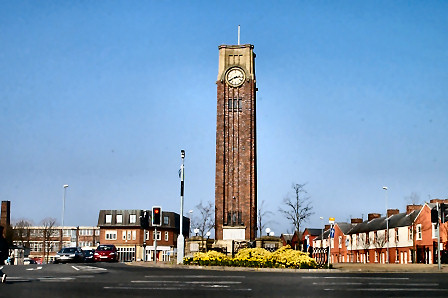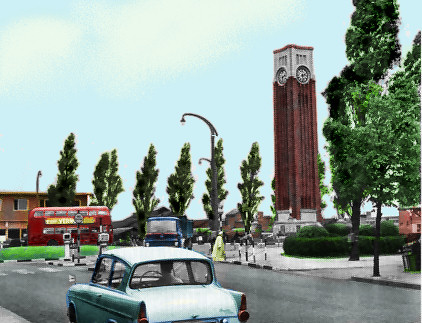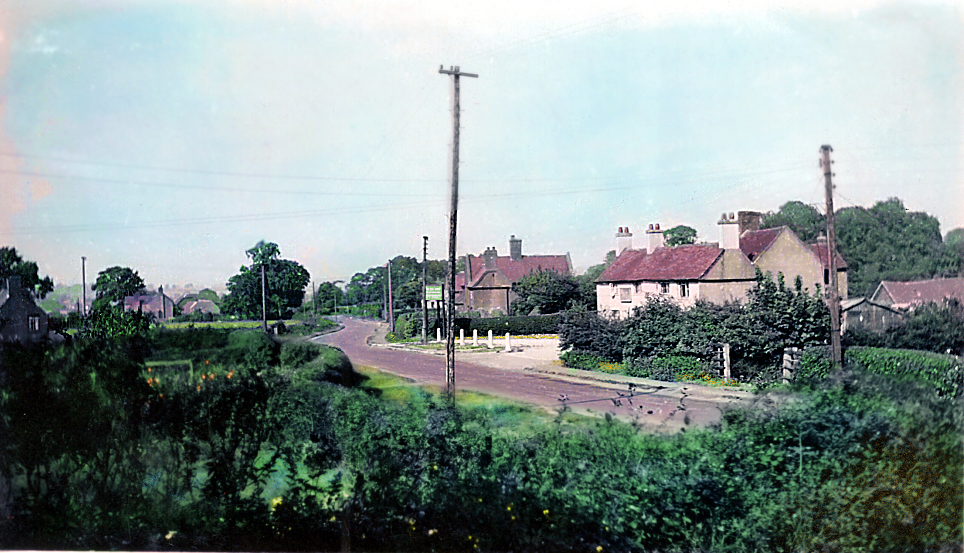COALVILLE
LEICESTERSHIRE  |
| The Clock Tower - the focal point of Coalville since the late 1800s when a market was held here. Originally, the area was called Long Lane, being
the very long lane that ran from Bardon on the road to
Leicester, right across and past Snibston pit and up the hill
towards Hoo Ash Farm and Ravenstone. The Clock Tower was built
in the early 1920s as a practical memorial to Coalville's war
dead. My memories are of being dragged around by my mother or
grandma, past endless green-canvassed market stalls all round to
the right of the square, and quite a few along the left-hand
side behind the bus stops along from the new post office, just
behind that Midland Red bus on the image below. The bus has
probably just come in from Ashby, and will set down on that far
side, before coming round by the back of the Tower to its
pick-up point for Leicester, just behind those mounds of shrubs
on the corner.  All traffic went around the Tower, just as for a very large traffic island. Buses had their termini on both sides, and the road where the cars have come from in the top photo still leads to Whitwick, dipping down under the railway bridge that takes what is now just a freight line on to Ashby. There was a pub on three corners of the square; two of them are still on the corners of Belvoir Road behind the camera, and one to the right on the market corner. The rest were shops of every kind, row upon row of
those ubiquitous green canvas window blinds, especially up and
down the main shopping street, Belvoir Road. The fish n' chip
shop just by the Ashby bus stop was the best for miles around
and was one of the few at that time to sport a 'sit in' cafe
with a few seats for weary passengers waiting for or changing
buses. And just a little further along down Ashby Rd, who
recalls "Chad's Cafe". It had a sign outside - of a chad! This
establishment was also a popular haunt of BMMO crews from the
depot down the road. I only very recently discovered that one of
my aunts worked in that cafe at one time, towards the end of the
war and directly after. |
COLEORTON MOOR
 |
|
Coleorton Moor, looking north, past the Angel Inn, c.1955, taken from the front of what became "Haywood's Cottage". Rob & Jeff did a lot of their growing up around here at their grandparent's cottage on The Moor, especially between dad's RAF postings and various house moves. This used to be Arthur Haywood's cottage, famous round here in the 1950s for his 'left wing views', illustrated by his placing a huge life-size carving of a brown bear in the centre of the front garden. The brown bear was very much a symbol of Soviet Russia and notorious murderous leader, Stalin. I wonder where that went. Arthur was a 'one-off', very much out on the edge
of his family, and always at odds with them. The wider HAYWOOD
family seems to have come mainly from Griffydam, but the area's
graveyards are littered with the name, from Breedon in the
north, down through Worthington, Griffydam, Pegg's Green, and
Coleorton itself, to Ravenstone and Hugglescote in the south,
and over to Thringstone and Shepshed to the east. Perhaps most
of these Haywoods think they're unrelated - maybe, but the
earliest I know of is a Thomas, b.1802 in Griffydam, mine and
Jeff's g-g-g-grandad. A page of more Haywood
Family History. |
| Mum's HOLT family were in Highfield St,
Coalville, for most of the 20th century, at least from 1910 through to 1972. My grandfather, Harry Holt, was born to a mining family in Donington le Heath near Coalville, in 1893.  Harry served in both the Leicestershire and Northamptonshire regiments as a Lewis gunner during the very last days of the Great War. He'd signed up into the Leicesters TA in 1911, enlisted for war service on 5th Aug 1914, and was held back on account of his being a miner. By now married with two daughters, he finally got called in May 1918, sent to France in late September and took part in brief battles near Le Cateau along with the 2/Bedfordshires and Royal Fusiliers in early October. He demobbed in January 1919 from the 6th Battalion Northamptonshires. He returned home to his job as a miner at South Leicester Colliery at Ellistown, and had two more daughters, four in all, the last of which was Sylvia, our mum. This large pencil/charcoal drawing fascinated me when I was a boy. It hung over the sideboard in the back room at 208 Highfield Street, right up until he died of pneumonia, caught after a fall in the dark, ironically during a blackout, during the miners' strike of 1972! 
|
OUR FAMILY
VALERIE . . .
a former pupil of Sir Jonathan North Girls School
on Knighton Lane East, in Leicester.
Val left to pursue a career in floristry in 1967. Worked as a florist
for 6 years
at Simpkins & James in Horsefair Street, then Flowercraft in Cank
Street,
before we moved to Hull.
ROBERT . . .
a former pupil of Crown Hills Secondary School
on Gwendolen Road in Leicester.
Rob spent most of working life in the bus industry, firstly on Leicester
City Transport,
then later on both East Yorkshire Motor Services and Hull City
Transport.
Before joining LCT in 1968, worked for a short while at
Simpkins & James, where they first met.
Rob says that Val is his "Aylestone Duck". M'Duck.
Now retired ~~ for sure.
LCT . . 1968 -
1973 || EYMS
. . 1973 - 1979 ||
KHCT . . 1984 - 1993
View this page on the Net with a Side Menu of links?
Email us at : Rob & Val
members of:
Leicester & Rutland Family History Society - H0789
| |
OUR JOINT FAMILIES
a very stunted
tree
showing where we come from
|
ARTHUR
HAYWOOD |
HILDA SMITH of Aylestone Leicester |
HARRY
HOLT of Donnington |
VIOLETTA
MANDERFIELD |
|
JOHN
STEVENS |
EDITH BENNETT of Sharnford nr Hinckley |
THOMAS SWANWICK of Blaby Leicester |
ALICE
TOWNSEND FRETTER |
|
NORMAN
HAYWOOD |
SYLVIA
HOLT |
|
JACK
STEVENS |
JOAN
SWANWICK |
||||
|
|
ROBERT
HAYWOOD |
married Aylestone 1971 |
VALERIE
STEVENS |
|
||||
|
|
|
our three grand-daughters |
|
|
||||
|
|
|
ELEANOR
MAY - b. 2001 |
|
|
||||
Update to this short table;
HAYWOOD side:
The most recent information we currently have on each of our lines:
Arthur HAYWOOD'S grandfather was Josiah, b.Griffydam
1852,
and Josiah's grandfather, Thomas, was also living in Griffydam by
1820,
but where was he from. We think he was born in 1790... but where?
Harry HOLT'S father was b. Thurlaston, as was his
before him, in 1867,
but there is almost no trace of HOLT in Thurlaston - so where were
they really from?
Did they hail from Hugglescote in the first place, moving back there
from Thurlaston ?
It is surprising how much folks did move about, and occasionally
some
returned to their original roots. Perhaps we'll never know.
A temporary collection of some old Holt
Family Photos are on this link:
Violetta MANDERFIELD'S family are connected, back in
the 1700-1800's,
to the well-known ORRINGE and CORBETT lines of
Shepshed.
Arthur HAYWOOD'S maternal grandmother was Edith
ISON ,
daughter of HENRY HASTINGS ISON , b.1810, and himself a
descendant through his mother of the HASTINGS of
Humberstone,
who were of the same HASTINGS family that go back to Ashby and
Kirby Muxloe Castles, and way beyond to the Plantagenet era.
But that is just one line, amongst hundreds. Henry Hastings of
Humberstone, born
about 1605, is my 8th greatgrandfather up that direct line, but at
that level in
any family tree we all have 64 great-grandparents!
And I know nothing
whatsoever about any of the others, so that illustrates perfectly
that this particular
'bloodline' is very thin and diluted indeed. At the next level, it
is 128, then 256, and so on.
Another four or five generations, and we all have thousands and
thousands of
great-grandparents, hailing from just about everywhere in the
British Isles,
and a good bit of western Europe too. Few of us are from where we
think we're from.
The truth is, we're from just about everywhere ! And when we talk
about distant ancestry,
that is only true if all those grandfathers had the fathers they
thought they had.
A well-known family history truism is, "don't believe everything you
think."
STEVENS side:
John STEVENS' father and grandfather came from Hinckley
and Barwell,
but we now know that prior to that, in the early 1800s, from Enderby
and Croft,
with links before that back to Northamptonshire and Oxfordshire.
We now have a little more info on the BENNETTS of
Sharnford,
Val's branch originally came from North Kilworth, though there is a
mystery as to
why so many were called CAVE BENNETT back in the mid-1700's onwards,
around several dozen males of other surnames in the county had the
christian name, Cave.
Could this be a similar story to the HASTINGS name above? Are they
distantly related, or just grateful tenants.
The SWANWICK family, as far as we know, were always
from Blaby, as we have no trace prior to 1793.
And the FRETTERS originally came from Spratton and
Welford in Northamptonshire,
with connections to many of the villages thereabouts; Brixworth,
Cold Ashby, Naseby, etc.
Recent information from a LRFHS member suggests that the
SMITH family of Aylestone may well
have also hailed from Northamptonshire, in the village of Ruston.
There is a strong possibility that my SMITH Aylestone
family knew Val's FRETTER Aylestone family -
the 1881 Census shows their back gardens were adjacent. I wonder if
they got on okay?
SOME LEICESTERSHIRE AND EAST YORKSHIRE LINKS
|
AYLESTONE ST ANDREWS OFFICIAL WEBSITE Recommended ! A good history of the church, plus many more photos, also a Virtual Tour, and Panorama of the interior, Parish Groups, Scouts, etc, and links to other Aylestone churches. Excellent Site!! |
Sutton & Wawne Museum in Sutton on Hull, East Yorkshire Family History, and links to War Memorials, etc, plus the excellent and acclaimed Resource Centre within the museum hosted inside the Old School, with more records & family history resources than you can shake a stick at. |
|
The Royal
Society of St George Patron : H M The Queen See what Englishness is all about, and why it's under threat. |
HUMBER CARS Sorry, old site now defunct. Collection has been sold. It's not generally known even in Hull, but the founder of the famous marque of HUMBER CARS actually lived in the town for a time. This link used to take you to one of Hull's gems, the largest working collection of these superb cars anywhere in the world. |
|
LEICESTERSHIRE OVERSEAS with the passing of Tim Airey in 2006, this site has long closed, but some of it can still be accessed through the fantastic WAY BACK MACHINE , a superb archive of old sites going back several years. See more information on Home Page. |
HULL CIVILIAN WAR DEAD INDEX - a list of all the city's 1,280 or so civilian casualties of the Hull Blitz; a terrible archive, and a record of one city's price for its north-east coast location. |
|
LEICESTERSHIRE & RUTLAND FAMILY HISTORY SOCIETY one of the best family history sites on the whole of the web - bar none! |
BOMB MAPS OF HULL - 1945 Grid of all 16 maps - in a 4x4 grid, take 2.28 Mb of space links to the index above, showing the actual location and type of enemy bombs during five years of war |
|
Good quality photographs of LEICESTERSHIRE & RUTLAND CHURCHES Dozens of churches now listed, this well-laid out site is growing nicely. |
HULL'S GARDEN VILLAGE , its history; the new houses, war damage, and 2007 Flood, and lots more to do with East Hull. Lots of excellent photos, a real flavour of the area. |
|
the Leicestershire Legend of BLACK ANNIS a wonderfully told tale linking local legend with actual history. So, why DID King Richard lose his crown on Bosworth Field? And what's the connection with Donington Manor? Kids will love this. |
THE
STORY OF A HOUSE in Hull during the Blitz Our house - and the unfolding story of the unfortunate family that first bought it in 1934, and the tragedy of total war. The GPO War Dead Memorial - Hull A link from the family above, as their daughter worked for the GPO, and is named on the memorial as the only civilian, and the only 'Miss'. |
|
A UK PHOTO RESOURCE GEOGRAPH ORG UK run by the Ordnance Survey - a brilliant resource of photos of just about every map grid square in the country! Dozens of photos of all towns - lots of both Hull and Leicester. This is the one we've been waiting for. |
See these superb CITY OF DERBY PHOTOS by Andy Savage. Over 800 photos of the city, and Derbyshire towns and villages, and some in Staffs and Leicestershire too. Would that Leicester had a site only half as good! |
|
The Music
Education Council - we're strong believers in the re-establishment of music education in schools. For those that feel as strongly, this needs your support. |
Yorkshire Births Marriages & Deaths A free index concentrating on Yorkshire only, superb to navigate, with BM&D registrations since 1837, and in many cases, up to the 1950's. |
|
An excellent local village website, dedicated to both family
history and social history, with a full list of burials in their chapel churchyard. GRIFFYDAM HISTORY GROUP lots of Haywoods in there! |
|
|
The Whos-Who of Radical Leicester --- an excellent
site by Ned Newitt The other side to Leicester's history that I should have taken more notice of when at school. I have a grandfather listed on here, Arthur Haywood. WHO'S-WHO of RADICAL LEICESTER "This site is about the many people who have been involved in the continuing struggle for social justice in the Leicester area. It aims to provide a short biography of those individuals who tried, in some way, to improve the life of their fellow citizens. I hope that this site can remind us of their contribution and tell us something of the issues they faced and the obstacles they had to overcome." Ned Newitt |
|
| TWO SONNETS My father, the late Norman Haywood
of the RAF pages, had two brothers, both now sadly deceased.
One, my late Uncle Don, was an unpublished poet, who also
served in the RAF, and later worked at Snibston and Lount
pits before a lifetime of service with Severn-Trent Water
Board. I have placed a few of his lines below; 'Sonnets from the Edge of War' as a memorial to all those of his and my father's generation, who spent much of their childhood 'down the shelters', or otherwise deprived and disadvantaged by war. Born
in 1930, Don's memories are of the events in and around
Gough Road, in Leicester, during those years of the blitz.
It was a major 'target area' for the Luftwaffe, with so
much engineering and industrial premises around.
Gough Rd is at the northern end of the St Barnabas Rd-East
Park Rd industrial area, with St Saviours and Green Lane
Roads nearby. There was a major boot & shoe factory at
the top of their street. A good many of the machines that
manufactured most armaments, from small arms to tanks and
artillery, or repaired equipment essential for the war
effort, was made in Leicester. Major shoe factories, that
would make boots for all three armed services, were in the
city. Thankfully
the area would not be heavily hit, but it was expected to
be so. It is a sobering fact that today's youth would not,
could not, put up with as much. Is this how it was for
you? These lines quite moved me when I first read them.
What did my Mum and her sisters think, as a 10-year old,
as she stood at the bottom of her father's Coalville
garden and watched the glow in the sky over the fields as
Coventry burnt, some 25 miles away? |